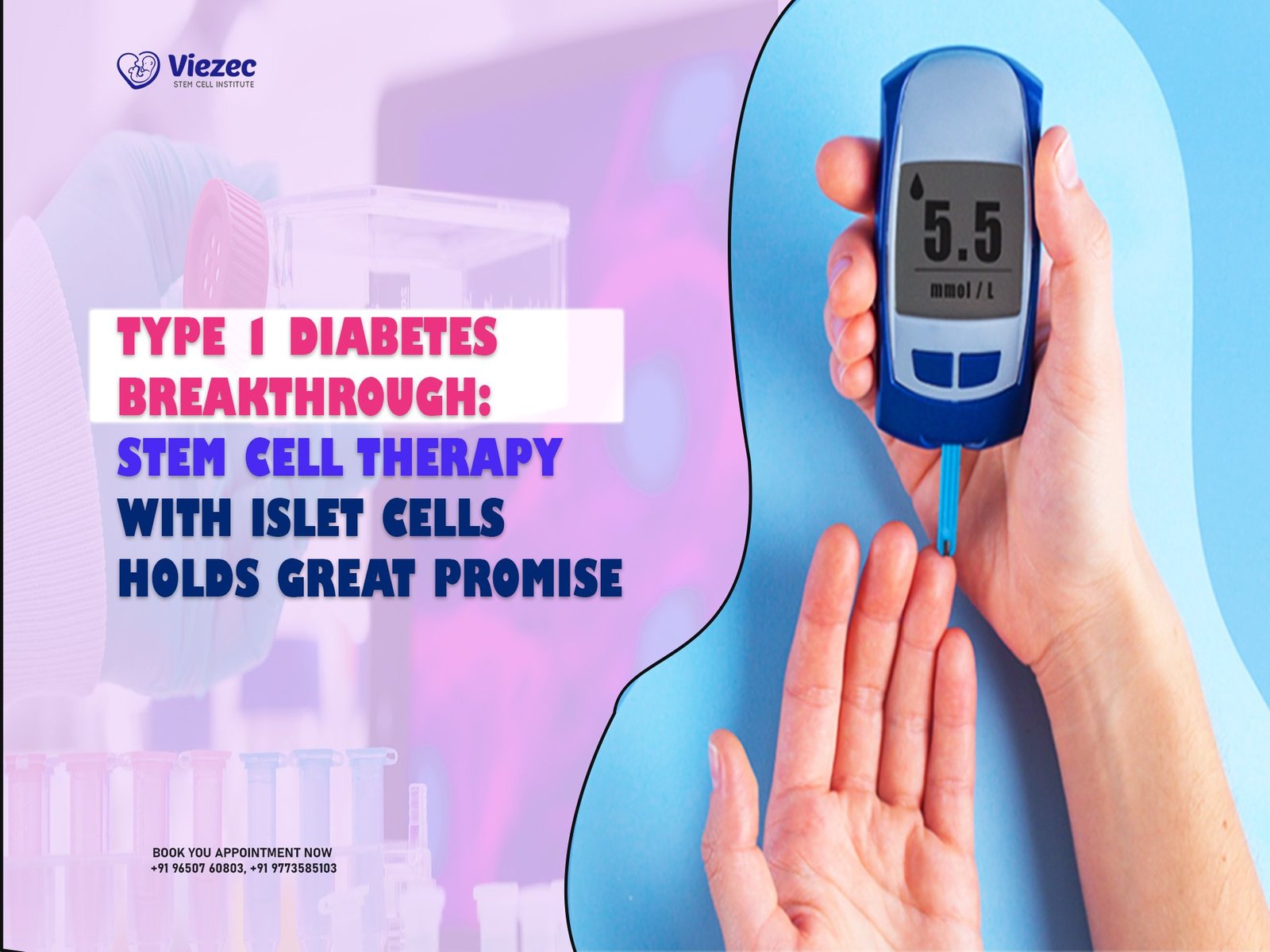Diabetes mellitus, commonly known as diabetes, is a chronic metabolic disorder characterized by elevated blood sugar levels. It affects millions of people worldwide and is associated with various complications, including heart disease, kidney failure, and vision problems. While conventional treatments such as insulin therapy and medications can help manage diabetes, there is growing interest in exploring alternative approaches, and one promising avenue is stem cell therapy. This article delves into the current state of knowledge on the potential of stem cell therapy in curing diabetes.
Understanding Diabetes
Before exploring the potential of stem cell therapy, it’s crucial to understand the underlying mechanisms of diabetes. Diabetes is primarily classified into two types: Type 1 and Type 2.
Type 1 Diabetes
Type 1 diabetes is an autoimmune condition where the immune system mistakenly attacks and destroys insulin-producing beta cells in the pancreas. Insulin is a hormone that regulates blood sugar, and the destruction of these cells leads to insufficient insulin production.
Type 2 Diabetes
Type 2 diabetes is characterized by insulin resistance, where the body’s cells do not respond effectively to insulin. This results in the pancreas producing more insulin to compensate, but eventually, it can’t keep up with the demand, leading to elevated blood sugar levels.
Stem Cells: The Basics
Stem cells are undifferentiated cells with the unique ability to differentiate into various cell types. They are the building blocks of the body, playing a crucial role in development, tissue repair, and regeneration. There are two main types of stem cells: embryonic stem cells and adult (or somatic) stem cells.
Embryonic Stem Cells
Embryonic stem cells are pluripotent, meaning they can give rise to all cell types in the body. They are derived from embryos, typically from the blastocyst stage, and have the potential to differentiate into any cell type.
Adult (Somatic) Stem Cells
Adult stem cells, also known as somatic or multipotent stem cells, are found in various tissues throughout the body. Unlike embryonic stem cells, they are more specialized and can differentiate into specific cell types related to the tissue where they are located. Examples include hematopoietic stem cells in the bone marrow and neural stem cells in the brain.
Stem Cell Therapy for Diabetes
The idea behind using stem cells for diabetes treatment is to replace or regenerate the damaged insulin-producing cells in the pancreas. This can be achieved through different approaches, each with its unique set of challenges and potential benefits.
Differentiation of Stem Cells into Beta Cells
One approach involves differentiating stem cells, either embryonic or induced pluripotent stem cells (iPSCs), into insulin-producing beta cells. This can be achieved through a series of carefully controlled steps that mimic the natural development of beta cells in the pancreas.
Challenges
However, challenges arise in ensuring that the differentiated cells closely resemble natural beta cells in terms of function and regulation. Controlling the maturation process to produce fully functional beta cells is a complex task that researchers are actively working on.
Transplantation of Stem Cell-Derived Beta Cells
Another avenue is the transplantation of stem cell-derived beta cells into the pancreas. This involves introducing the differentiated cells into the patient’s pancreas, where they can integrate into the existing tissue and start producing insulin.
Immune System Challenges
One major hurdle in this approach is the immune response. Since the cells are derived from foreign sources (either embryonic stem cells or iPSCs), there is a risk of rejection by the recipient’s immune system. Researchers are exploring ways to overcome this challenge, such as immunosuppressive drugs or encapsulation techniques that protect the transplanted cells.
Inducing Regeneration of Endogenous Beta Cells
Stem cell therapy can also be aimed at stimulating the regeneration of the patient’s own beta cells. This involves using specific signals or factors to encourage the remaining beta cells to proliferate and replace the damaged ones.
Microenvironment Factors
Understanding the microenvironment or niche in which beta cells reside is crucial for this approach. Factors that promote beta cell regeneration in the pancreas, such as certain growth factors and signaling molecules, are actively being studied.
Clinical Trials and Research Findings
The potential of stem cell therapy for diabetes has garnered significant attention in the scientific community. Numerous preclinical studies and clinical trials have been conducted to assess the safety and efficacy of different stem cell-based approaches.
Encouraging Preclinical Results
In preclinical studies using animal models, researchers have demonstrated the successful generation of functional beta cells from stem cells. These studies provide valuable insights into the potential of stem cell therapy for diabetes, showing improvements in blood sugar regulation and increased insulin production in treated animals.
Challenges in Translation
However, translating these findings from animal models to human clinical trials presents its own set of challenges. The complexity of the human body and the specific requirements for safety and efficacy in human applications necessitate thorough testing and refinement of stem cell therapies.
Human Clinical Trials
Several clinical trials have been initiated to evaluate the safety and efficacy of stem cell therapies for diabetes in humans. These trials aim to address key questions, such as the long-term viability of transplanted cells, potential side effects, and the overall impact on diabetes management.
Ongoing Trials
As of the current date, multiple clinical trials are in progress, utilizing different stem cell approaches for both Type 1 and Type 2 diabetes. These trials involve diverse patient populations, including those who have recently been diagnosed and individuals with longstanding diabetes.
Mixed Results
While some trials have shown promising results, with participants experiencing improved insulin production and better blood sugar control, others have reported mixed outcomes. Factors such as the type of stem cells used, the transplantation method, and the duration of follow-up all contribute to the variability in results.
Challenges and Considerations
Despite the promising potential of stem cell therapy for diabetes, several challenges and ethical considerations need to be addressed.
Ethical Concerns
The use of embryonic stem cells raises ethical concerns due to the need to harvest cells from embryos, which involves the destruction of the embryo. This has led researchers to explore alternative sources, such as induced pluripotent stem cells, which can be generated from adult cells without the need for embryos.
Immune Response
The immune response remains a significant challenge in stem cell transplantation. Strategies to prevent rejection, such as immunosuppressive drugs, carry their own set of risks and complications, including an increased susceptibility to infections and potential long-term adverse effects.
Tumorigenic Risk
One of the concerns associated with stem cell therapy is the potential for tumorigenesis. Pluripotent stem cells, in particular, have the capacity to form tumors if not properly controlled. Ensuring the safety of stem cell therapies requires rigorous testing and monitoring to minimize the risk of tumorigenicity.
Standardization and Regulation
Standardizing stem cell therapies for diabetes is a complex task, given the variability in treatment approaches and patient populations. Establishing clear regulatory guidelines and standards for these therapies is crucial to ensure their safety and efficacy.
Future Directions and Optimism
Despite the challenges, the field of stem cell therapy for diabetes continues to advance, with researchers exploring new avenues and refining existing approaches.
Advances in Cell Reprogramming
The development of induced pluripotent stem cells (iPSCs) has been a significant breakthrough, offering a potential solution to the ethical concerns associated with embryonic stem cells. iPSCs can be generated from adult cells, providing a source of pluripotent cells without the need for embryos.
CRISPR-Cas9 Gene Editing
The advent of CRISPR-Cas9 gene editing technology has opened up new possibilities for refining and enhancing stem cell therapies. Researchers can use this technology to precisely edit the genome of stem cells, addressing specific challenges such as immune rejection and tumorigenicity.
Combination Therapies
The future of stem cell therapy for diabetes may involve a combination of approaches, including stem cell transplantation, gene editing, and other adjunct therapies. Combining different strategies could enhance the overall effectiveness and safety of these treatments.
Final Words
The question of whether diabetes can be cured by stem cell therapy is complex and multifaceted. While significant progress has been made in preclinical studies and early-phase clinical trials, challenges remain in translating these findings into widely applicable and safe treatments for a diverse range of patients.
The potential of stem cell therapy for diabetes is undeniable, holding promise for both Type 1 and Type 2 diabetes. However, careful consideration of ethical concerns, immune response challenges, and the potential for tumorigenicity is essential in guiding the development and implementation of these therapies.
As research continues to advance, it is crucial to maintain a balanced perspective on the potential of stem cell therapy for diabetes. While it may not provide a definitive cure in the traditional sense, it holds the potential to revolutionize diabetes management, offering innovative and personalized approaches to improve the lives of individuals living with this chronic condition. Continued investment in research, rigorous clinical testing, and collaboration between scientists, clinicians, and regulatory bodies are essential to realizing the full potential of stem cell therapy in the fight against diabetes.









